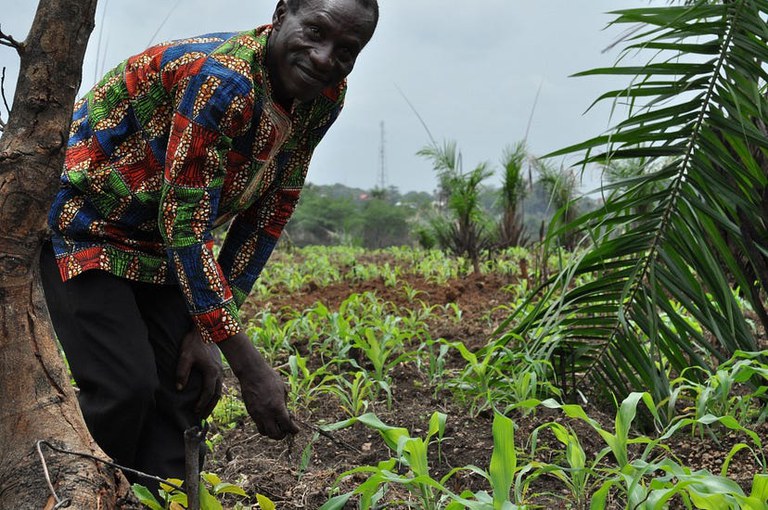How One Health Aligns with USAID Strategies and Policies

The world today is unprecedented in its complexity. To solve global development challenges and better mitigate against and respond to humanitarian disasters, we must break down historical silos and collaborate across sectors.
Download the One Health Strategy and Policy fact sheet.
View the One Health Evidence Collection.
What is One Health?
One Health (OH) is an integrated, unifying approach that aims to sustainably balance and optimize the health of people, animals, and ecosystems. It recognizes the health of humans, domestic and wild animals, plants, and the wider environment (including ecosystems) are closely linked and interdependent. If you work in development and humanitarian assistance, you already may be applying OH without calling it as such. Integration and cross-sectoral collaboration have long been promoted at USAID. What is new is that OH is now being formally and internationally acknowledged as a necessary approach to tackle complex problems, such as climate change, biodiversity loss, and food and water security, which require strategic, transdisciplinary solutions. Teams applying a OH approach synergize resources, examine options through a cross-sectoral lens to minimize potential conflicts, and design for innovative and comprehensive outcomes that benefit multiple sectors.
One Health in Relevant Strategies for USAID
Promoting more holistic and integrated development and humanitarian assistance increases efficiency and long-term, sustainable outcomes. USAID is incorporating a collaborative OH approach in its major strategies to address complex challenges.
The National Biodefense Strategy and Implementation Plan emphasizes the importance of engagement across many sectors to bring about the vision of attaining a world safe and secure from global health threats posed by infectious disease. USAID’s contributions to the strategy specifically promote “a OH approach that recognizes the interconnections among people, animals (domestic and wildlife), plants, and the environment as necessary to counter biological threats effectively and efficiently.” USAID global health security activities include strengthening the capacity of partner countries to understand and addressing the risks of zoonotic diseases that spillover from animals to humans; bolstering national surveillance systems and communication; training the next generation of health workers in OH; and informing the public about disease prevention and control. USAID has already provided billions of dollars to fight diseases such as COVID-19 and will continue to support efforts against new emerging diseases related to drivers such as climate change, land use change, and deforestation.
The USAID Climate Strategy (2022-2030) similarly encourages cross-sectoral collaboration that benefits the health of people and the planet by reducing risk of infectious disease, mitigating greenhouse gas emissions, and conserving ecosystems while also increasing food security and strengthening community resilience. The strategy states that “USAID is committed to addressing the interconnections among human, animal, and environmental health using a multisectoral OH approach.” During its launch last spring, the USAID Administrator stated that, “Rather than dictate, bureau by bureau, region by region, mission by mission, dozens of individual climate initiatives, our new climate strategy lays out six audacious and inspiring goals and challenges us all to play our part.” In the past year, USAID has conserved more than 60 million hectares of forests, mangroves, and other lands that absorb and store carbon and aims to restore and conserve a total of 100 million hectares of critical landscapes by 2030.
The Global Food Security Strategy (2022-2026) promotes OH principles through multi-sectoral collaborative partnerships and the adoption of climate-smart and sustainable agribusiness models that value and account for natural resources, health and nutrition outcomes, and social inclusion. The strategy explicitly states that USAID “will consider the interactions and potential cross-sectoral impacts across human, animal, and ecosystem health, which reduces exposure and controls emerging threats such as pests and disease.” The strategy supports the expansion of integrated approaches, such as OH, through activities such as agroforestry, perennial cropping, soil health enhancement, and improving water resources management which enhance sustainable agriculture and community resilience. USAID activities for global food security include equipping smallholder farmers and bakeries in Niger to source locally grown sorghum, reducing food loss and waste in Ghana with storage bags treated with natural extracts, and supporting businesses in Haiti to invest in improved food-processing equipment for rice mills and cooking oil producers that better fortifies foods to boost nutrition.
Other Strategies and Policies Aligning with One Health
Other pertinent strategies and policies for USAID capture the essence of OH through their collaborative and integrative nature even though they do not name OH specifically:
- The Global Water Strategy (2022-2027) supports a vision of building health, prosperity, stability, and resilience through sustainable and equitable water resource management. The strategy reinforces OH through its interconnected and mutually reinforcing objectives that include strengthening social structures, increasing access to water and hygiene services, improving conservation and management of ecosystems, and reducing conflict related to water.
- The USAID Multi-Sectoral Nutrition Strategy (2014-2025) fosters coordinated efforts from multiple sectors (agriculture, health, water, education, environment, economic growth, livelihoods, and social protection) across multiple platforms (public, private, and civil society) to improve and ensure effective nutrition-specific and nutrition-sensitive interventions. The strategy emphasizes the multifaceted basic and underlying determinants for successful nutrition and health, development, educational, economic, and environmental outcomes that are sustainable.
- The USAID Biodiversity Policy (2014) emphasizes integrated and collaborative programming by emphasizing cross-sectoral engagement to improve understanding, collaboration and cohesion across bureaus and missions. It prioritizes the integration of biodiversity conservation into other development sectors, understanding that biodiversity and sustainable natural resource management are foundational to build healthier populations, increase resilience, and create lasting economic opportunities. The Biodiversity Policy is being updated in 2023, and will continue strong emphasis on cross-sectoral collaboration.
U.S. One Health Leadership
For more information about how other USG agencies are utilizing OH, please follow the links below:


